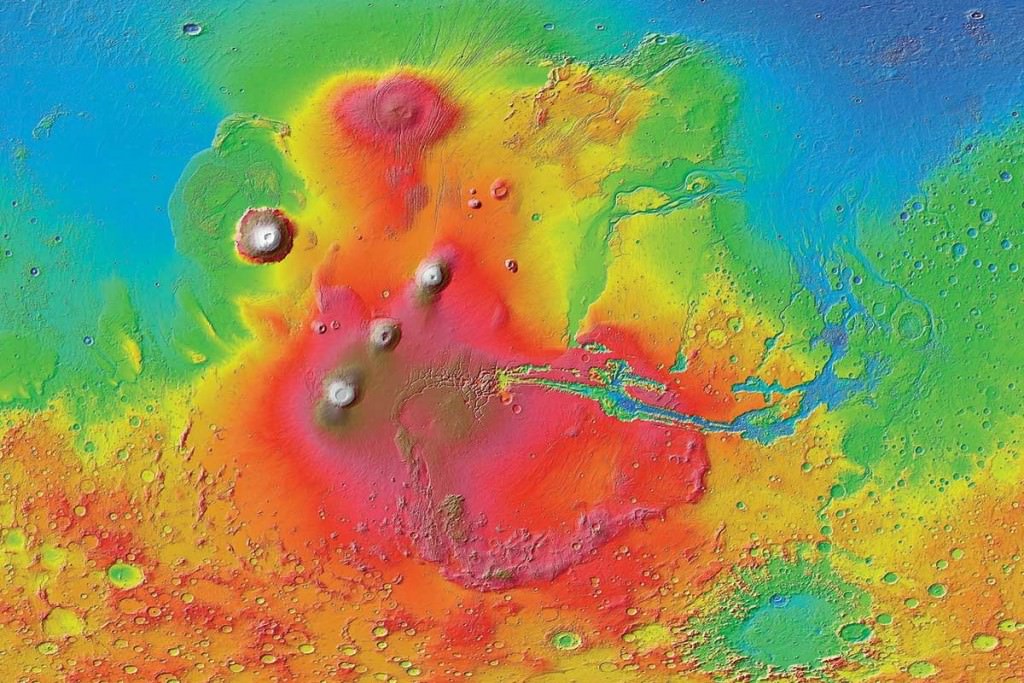What’s Under This Hole on the Surface of Mars?
Human visitors to Mars need somewhere to shelter from the radiation, temperature swings, and dust storms that plague the planet. If the planet is anything like Earth or the Moon, it may have large underground lava tubes that could house shelters. Collapsed sections of lava tubes, called skylights, could provide access to these subterranean refuges.
Does this hole on Mars lead to a larger underground cavern?
This image was captured by the High-Resolution Imaging Science Experiment (HiRISE) camera on NASA’s Mars Reconnaissance Orbiter (MRO). The pit is only a few meters across and is in the Arsia Mons region of Mars. Arsia Mons is one of the three dormant volcanos in the Tharsis Montes group of three volcanos.

The Tharsis Region of Tharsis Bulge is a vast volcanic plain that’s thousands of kilometres across. It’s elevated compared to the rest of Mars and averages about 10km (33,000 ft) above the planet’s mean elevation. The region was volcanically active in the past, obviously, and features like the pit are a direct result of ancient volcanic activity.
Several pits in the Arsia Mons region may be collapsed skylights or openings into subterranean lava tubes. However, there is much uncertainty. An image of one of them shows an illuminated sidewall, which could indicate that it’s just a cylindrical pit.

The hole in the featured image could be only a pit or shaft and not an entrance to a cave or lava tube. They’re found on Hawaiian volcanos, where they’re called pit craters. They don’t connect to long caves or lava tubes. They’re the result of a collapse that happened much deeper underground.

In Hawaii, the pit craters range from 6 to 186 m (20 to 610 feet) deep and from 8 to 1140 m (26 to 3,740 feet) wide. The Arsia Mons pit in the leading image is only about 178 m (584 feet) deep.
We have a much better understanding of lava pits and tubes on the Moon than we do on Mars. We know some of them are thermally stable at about 17 C (63 F.) We also have better images of them, with intriguing glimpses of boulder-covered floors.

Lots of thinking is going into how to explore these lunar caves and lava tubes, including conceptual designs for robots that could explore them. Maybe on the Moon, astronauts could take shelter in inflatable habitats inside these tubes, where they’re protected from temperature swings, radiation, and micrometeorites.
But Mars is another question. There’s no reason that lava tubes shouldn’t exist on Mars. In fact, Mars’ gravity is much weaker than Earth’s, and that should allow for much larger tubes. Images of Mars show rilles, which are collapsed tubes. It seems likely that not all of these tubes have collapsed to form rilles.
One pit on the Martian volcano, Pavis Mons, is particularly intriguing. There’s some kind of void under the pit, but the nature of the pit is difficult to ascertain. Is it a lava tube? If it is, it dwarfs most tubes on Earth.
Martian lava tubes are still a mystery. Scientists have found plenty of morphological evidence suggesting that they’re plentiful. But in science, you can’t assume they’re there, even though it seems likely that they are. There’s no clear reason why they wouldn’t be. Could they one day provide shelter for astronauts? Maybe.
We need a robotic mission to explore them first.
The post What’s Under This Hole on the Surface of Mars? appeared first on Universe Today.
Source: https://www.universetoday.com/167167/whats-under-this-hole-on-the-surface-of-mars/
Anyone can join.
Anyone can contribute.
Anyone can become informed about their world.
"United We Stand" Click Here To Create Your Personal Citizen Journalist Account Today, Be Sure To Invite Your Friends.
Humic & Fulvic Liquid Trace Mineral Complex
HerbAnomic’s Humic and Fulvic Liquid Trace Mineral Complex is a revolutionary New Humic and Fulvic Acid Complex designed to support your body at the cellular level. Our product has been thoroughly tested by an ISO/IEC Certified Lab for toxins and Heavy metals as well as for trace mineral content. We KNOW we have NO lead, arsenic, mercury, aluminum etc. in our Formula. This Humic & Fulvic Liquid Trace Mineral complex has high trace levels of naturally occurring Humic and Fulvic Acids as well as high trace levels of Zinc, Iron, Magnesium, Molybdenum, Potassium and more. There is a wide range of up to 70 trace minerals which occur naturally in our Complex at varying levels. We Choose to list the 8 substances which occur in higher trace levels on our supplement panel. We don’t claim a high number of minerals as other Humic and Fulvic Supplements do and leave you to guess which elements you’ll be getting. Order Your Humic Fulvic for Your Family by Clicking on this Link , or the Banner Below.
Our Formula is an exceptional value compared to other Humic Fulvic Minerals because...
It’s OXYGENATED
It Always Tests at 9.5+ pH
Preservative and Chemical Free
Allergen Free
Comes From a Pure, Unpolluted, Organic Source
Is an Excellent Source for Trace Minerals
Is From Whole, Prehisoric Plant Based Origin Material With Ionic Minerals and Constituents
Highly Conductive/Full of Extra Electrons
Is a Full Spectrum Complex
Our Humic and Fulvic Liquid Trace Mineral Complex has Minerals, Amino Acids, Poly Electrolytes, Phytochemicals, Polyphenols, Bioflavonoids and Trace Vitamins included with the Humic and Fulvic Acid. Our Source material is high in these constituents, where other manufacturers use inferior materials.
Try Our Humic and Fulvic Liquid Trace Mineral Complex today. Order Yours Today by Following This Link.






